Fluorescent lamps: parameters, device, circuit, pros and cons compared to others
Modern fluorescent lamps (FL) do an excellent job of lighting large residential, work and technical premises and can reduce overall electricity consumption by 50-83%, thus reducing utility bills.
In this article, we will consider the operating characteristics of LLs, their design, and analyze the main advantages and disadvantages in comparison with other types of lighting devices. In addition, we will provide thematic photos and diagrams, as well as videos about the operating principle of fluorescent light bulbs and the features of their application.
The content of the article:
Operating principle and device of LL
A luminescent device is a gas-charged light source, where an electrical discharge in mercury vapor creates intense ultraviolet radiation.
Compact fluorescent-type modules have a standard base, which makes them a convenient replacement for bright, but more energy-consuming incandescent lamps.
How does a fluorescent light bulb work?
It is transformed into light visible to the human eye by a special composition called phosphor, consisting of calcium halophosphate mixed with additional elements.
After connecting a fluorescent lamp to the central power supply, a so-called glow discharge must be maintained inside the glass bulb.
It makes it possible to ensure the glow of the phosphor layer in constant mode and even during a short-term outage of the central power supply.
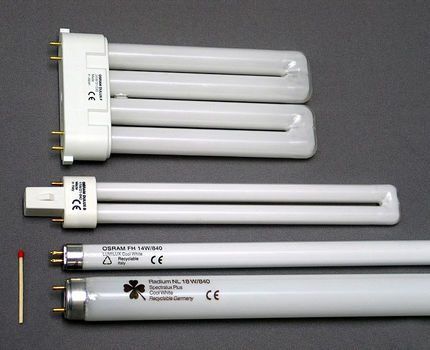
Design features of the device
The traditional fluorescent type lamp is a glass cylinder with an outer diameter of 12, 16, 26 and 38 mm, usually represented as:
- straight extended tube;
- curved U-shaped module;
- ring;
- complex figure.
The legs are hermetically sealed into the end edges. On their inner side there are tungsten electrodes, which are structurally reminiscent of the spiral filament bodies built into Ilyich light bulbs.
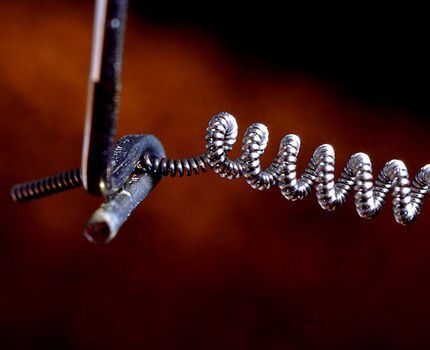
From the outside, the electrode elements are soldered to the metal pins of the metal plinth, to which operating voltage is applied.
U-shaped and straight devices are usually equipped with G5 and G13 bases, where the letter coding indicates the pin type of the base element, and the number indicates how far apart the working elements are located.
The electrically conductive medium located inside the glass bulb has negative resistance. When a current increase occurs between two opposing electrodes that requires limiting, it manifests itself and reduces the operating voltage.
The circuit diagram for switching on a conventional fluorescent light bulb includes throttle or ballast. It is responsible for creating the high-level pulse voltage necessary to correctly activate the lamp.
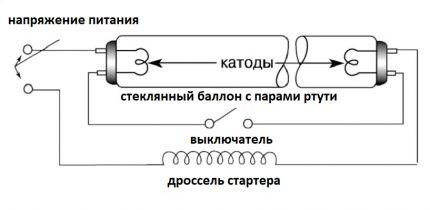
In addition to this part, the electronic ballast is equipped with starter. It is a glow discharge element, inside of which there are two electrodes surrounded by an inert gas environment.
One of them consists of a bimetallic plate. In sleep mode, both electrodes are open.
Common types of such light bulbs
The primary classification of fluorescent-based products is based on the level of base pressure. High pressure devices are used for high power lighting installations and outdoor street lighting.
Low pressure lamps are used in everyday life to supply light to industrial, technical and residential premises for various purposes.
Type #1 - high pressure modules
High-pressure devices produce a rich light flux of good density. The inner surface of the bulb element has a special phosphor coating made of fluorogermanate or magnesium arsenate.
The operating power of such fluorescent lamps ranges from 50-2000 W.
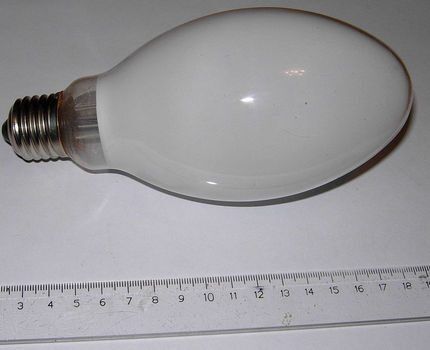
Full ignition of the lighting module occurs within 3 seconds.The service life of 80-125-watt products is about 6,000 hours, and lamps from 400 W or more can work up to 15,000 hours if the operating rules established by the manufacturer are strictly followed.
Type #2 - low pressure products
Low pressure LL is used to provide light flow to residential, technical and industrial premises.
Structurally, the device is a tube made of durable glass containing argon inside at a pressure of 400 Pa and a small amount of mercury or amalgam. It is offered on the market in a wide variety of modifications and is equipped with two electrode elements.
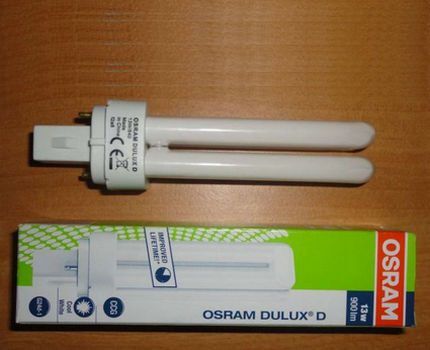
A glass flask can have a wide variety of diameters. The level of light output varies depending on the power of the device itself. For its correct operation, a throttle-type starter is required. Average service life is 10,000 hours.
Features of compact LLs
Compact-type LLs are hybrid products that combine some of the specific distinctive features of incandescent lamps and the characteristics of fluorescent lamps.
Thanks to advanced technologies and expanded innovative capabilities, they have the small diameter and medium-sized dimensions characteristic of Ilyich light bulbs, as well as a high level of energy efficiency characteristic of the LL line of devices.
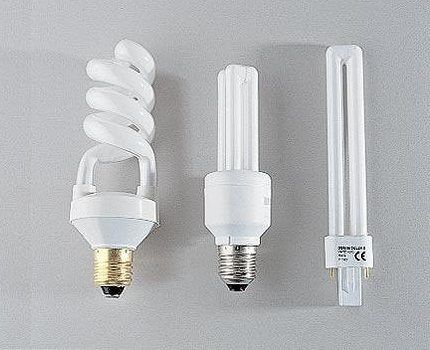
CFLs are in most cases equipped with an electronic choke and can be used in specific types of lighting fixtures. They are also used to replace simple and conventional incandescent lamps in new and vintage lamps.
Despite all the advantages, compact modules have such specific disadvantages as:
- stroboscopic effect or flickering - the main contraindications here concern epileptics and people with various eye diseases;
- pronounced sound effect – during prolonged use, an acoustic background appears that can cause some discomfort in a person in the room;
- smell – in some cases, products emit pungent, unpleasant aromas that irritate the sense of smell.
The last position is more often observed in nameless crafts of Chinese origin, and even branded devices made in accordance with all the rules and modern requirements often suffer from the first two. We have given the rating of the best CFL manufacturers In this article.
Basic range of color temperatures
The color of the glow is one of the most important parameters, directly dependent on the composition of the phosphor that converts ultraviolet radiation into light.
Today, the most common are 7 definitions of the shades of flux produced by fluorescent lamps:
- LEB – natural white with a noticeable cold tint;
- LDC – natural daytime with improved color rendering quality;
- LTB - warm white;
- LD – traditional daytime white;
- LB – classic white;
- LEC – natural with the highest quality rendition of shades;
- LHB – simple cool white.
For living spaces where people spend a lot of time, warm shades or natural daylight lamps with a high level of color rendering are suitable.
White and daytime tones are usually present in office, work, industrial spaces, classrooms and classrooms. They promote concentration, increase brain activity and improve overall learning and productivity.
The coolest shades are used in medical institutions, laboratories, hospitals and technical rooms. They give objects additional clarity and enhance visual acuity.
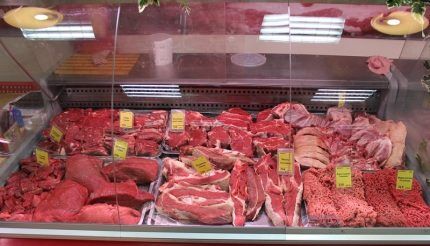
Color components added to the phosphor make it possible to obtain pink, blue, green and other unusual lamp shades.
Such devices are used for design, advertising and commercial purposes. With their help, they create an original glow that is necessary in a specific individual case.
We wrote more information about the color temperature of light, the peculiarities of human color perception and the nuances of choice in the next article.
Strengths and weaknesses of devices
Like any technical devices designed to illuminate domestic and work spaces, fluorescent lamps have their strengths and weaknesses.
Based on this information, you can determine where it is wiser to use them, and in which cases it is worth giving preference to light sources of a different type.
Positive aspects of lamps
The main advantage of luminescent products is considered to be increased light output and a good level of efficiency. They provide the room with lighting that is not irritating to the eyes, and demonstrate normal endurance even under intensive use.

Various temperatures of light shades, close in gamut to natural sunlight, allow you to select the appropriate lighting device for various purposes and for rooms of any purpose.
The light flow produced by the module is not directed, but scattered. A calm, pleasant-to-the-eye glow comes not only from the tungsten filament located inside, but also from the entire outer surface of the flask.
This allows the use of luminescent sources both to create general background lighting and to organize zonal light.
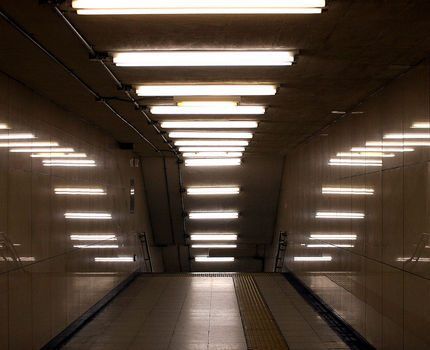
The service life of luminescent products varies depending on the model and reaches up to 20,000 hours or up to 5 years.
However, the buyer should know that the lamp produces this resource only if the following conditions are met:
- availability of a sufficient volume of high-quality power supply without surges and drops;
- qualitative ballast;
- a certain number of activations, usually no more than 2000 for the first 2 years of use, which is only 5 activations per day.
Violation of these basic conditions will significantly degrade the efficiency of the lighting fixture and significantly shorten its lifespan.
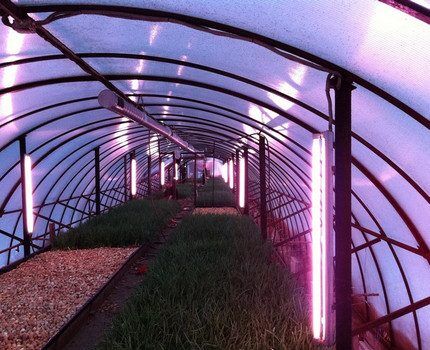
The energy consumption level of luminescent lamps is almost 5 times lower than that of traditional products, so they can be classified as energy saving light sources.
With their help, it will be possible to effectively illuminate a large room without spending a lot of money on utility bills.
The operating temperature on the surface of the flask does not exceed 50 degrees. This makes it possible to operate the lamp in rooms where increased fire safety requirements are imposed.
Main disadvantages of modules
The first big disadvantage of the products is excessive sensitivity to temperature changes. They react strongly to the movement of the mercury column and may stop working when the temperature drops below -20 °C.
Heat exceeding +50 °C does not have the best effect on the functioning and seriously limits the range of use of these light sources.
Moisture susceptibility is also not an advantage and does not allow the products to be widely used in bathrooms and sanitary facilities.
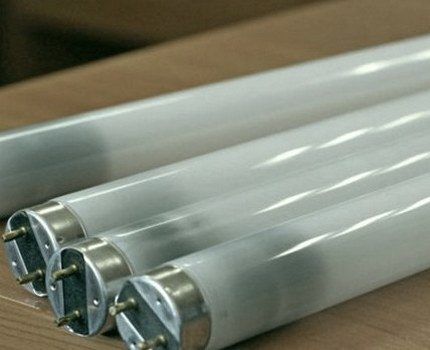
Sometimes the light flow itself is considered a disadvantage, as it has a lined, uneven spectrum that distorts the natural shades of objects in the room.
Not everyone feels this visually, but for those who perceive this minus too clearly, lamps are sold with a phosphor that is close to a solid, more natural spectral color. True, their light output is significantly less.
There are situations when luminescent lights flicker at twice the frequency of the supply network. This problem can be solved by some improvement of the device, in particular, by using electronic ballasts with a suitable level of capacitance of the smoothing capacitor of the rectified current at the inverter input.
But the fact that manufacturers are trying to save money and do not equip devices with capacitors of the required capacity is somewhat upsetting.
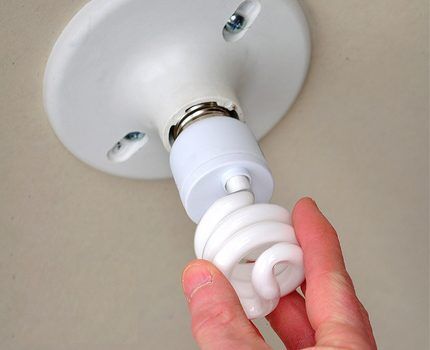
The need for an additional starting device also slightly reduces the popularity of lamps. They definitely require either an overly noisy and rather bulky throttle with a starter of low reliability or a more advanced electronic ballast that has a power adjustment function, but at the same time costs a lot of money.
Another weak point of luminescents is their high sensitivity to switching on. During direct activation of the lamp, a special composition burns out and crumbles on the electrodes, which ensures discharge stability and protects the internal tungsten filament from overheating.
Constant switching on significantly reduces the service life of the device. In addition, a visible, irritating flicker appears, and the edges of the lamp bulb darken and lose their aesthetics.
Chemical health hazard
One of the main disadvantages of fluorescent light sources is the chemical hazard. The lamp bulb contains highly toxic mercury, and its amount ranges from 1 to 70 mg.
The vapors of this substance can harm the health of people who are constantly in rooms illuminated by LL-type devices.
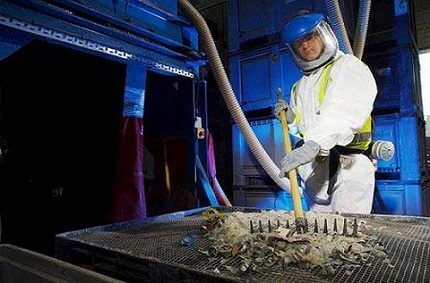
When a module fails, under no circumstances should it be broken or thrown into an ordinary trash bin. It's necessary dispose of according to regulations and rules clearly described in current legislation.
For example, transported to landfills where toxic materials are accepted from the population for their correct destruction or recycling.
Comparison with other light sources
LL-type products differ significantly from both aging incandescent lamps and progressive LED lamps.
Compared to the first ones, they consume 5 times less electricity, while providing the same level of light flux saturation. But they are somewhat inferior to LED devices in terms of power combined with energy consumption.
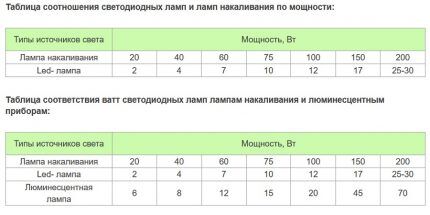
True, an incandescent lamp burns with the same intensity throughout its entire operating period, while fluorescent lamps lose some of their saturation due to the burnout of the inner layer that reflects ultraviolet light.
LED products become somewhat dim during operation due to degradation of the working diodes. And in some models it is possible to adjust the brightness of the lighting using a dimmer.
Incandescent or fluorescent lamps do not provide this function.But this convenient mode in LED devices is not free and you will have to pay an additional amount for it.
In terms of the level of structural fragility, incandescent lamps and fluorescent lamps are similar, since they have a glass bulb. In this regard, ice modules are more resistant to shock and mechanical damage. And the absence of any harmful or toxic elements inside makes them much more attractive for use at home.
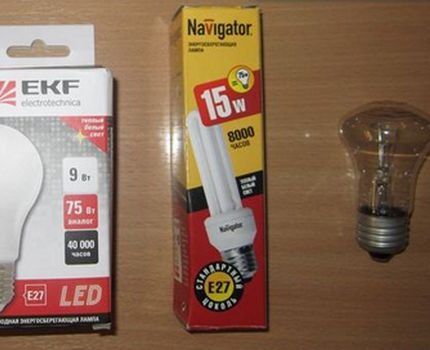
As for the financial side, initially an incandescent light bulb costs less than others. However, given its working life of only 1,000 hours, this can hardly be considered a pronounced advantage.
The basic price of fluorescents is higher, however, and they last much longer. As reputable manufacturers say, they last for 10,000-15,000 hours if the number of daily activations does not exceed 5-6 times.
LED modules can boast even better performance, but you will also have to pay much more for this pleasure, and this is not advisable in all cases. Although the tendency to replace some light sources with others can be seen everywhere. About the need to replace fluorescent light bulbs with LED ones and the procedure for performing this work we wrote here.
Conclusions and useful video on the topic
On what principle do luminescent lamps work? A detailed explanation of all the nuances of the functioning of economical and energy-efficient lighting devices:
What are the main differences between fluorescent elements and simple and traditional incandescent lamps? Comparison of power, light output and energy consumption of two modern lighting products:
What are compact energy-saving fluorescent light bulbs? How they work, how many watts they consume and for what purposes they are used:
A fluorescent type device is a practical analogue of a classic incandescent lamp. With its help, you can provide high-quality light flow to a room of any size, while reducing energy consumption. It will serve for a long time and will not cause any significant trouble to the owners..
Then, when the lamps have reached the end of their useful life, they will need to be disposed of and new, more advanced modules purchased in return.
What type of light bulbs do you prefer and what do you think about fluorescent light bulbs? Share your opinion with other users, tell us what you see as the main advantages of LL, and what, for you personally, is a significant disadvantage of these devices.
If you have good theoretical knowledge on the topic of the above article and want to supplement our material with useful nuances, please write your comments in the block below.




Considering my own experience in operating lamps of various types, I would give preference to fluorescent ones. The key factors for me are the too short life of incandescent lamps and my personal intolerance to LED lighting. It hurts my eyes, and also seems somehow cold and unnatural. Moreover, everyone at home agrees with me. I would like to know: what is this effect, or is it just an individual perception?
Hello. There are several versions from scientists.
The higher the temperature of the color spectrum, the stronger the irritation on the retina. It is recommended to use LED lamps with warm light, radiation temperature 2500-3200 K. If the indicator is higher, such a lamp should be discarded. In addition to physiological factors, this moment is also neurological in nature - warm yellow light is characteristic of sunlight, but cold white light does not exist in nature.
LED light bulbs with a flickering frequency of 8-300 Hz also have a bad effect on the nervous state, but this applies to light bulbs that do not have built-in filtering. In addition, LED lamps, according to recent studies, reduce the production of melatonin, this is a special hormone that is responsible for stabilizing sleep and daily cycle in general, and also has an antioxidant effect.
But in general, the issue of the harm of such lamps has not yet been sufficiently developed and studied. Whatever it is, if you are uncomfortable and uncomfortable with them, then why torture yourself, it’s easier to really take an alternative option.
I replaced all the light bulbs in my apartment with fluorescent ones and immediately felt a 60 percent energy saving. The phosphor is very pleasant to the human eye, the lighting in the rooms is much better and more efficient. You can choose lighting that is pleasing to the eye, the flow of light is diffused. Of course, they are more expensive financially, but then you will immediately feel their benefits.